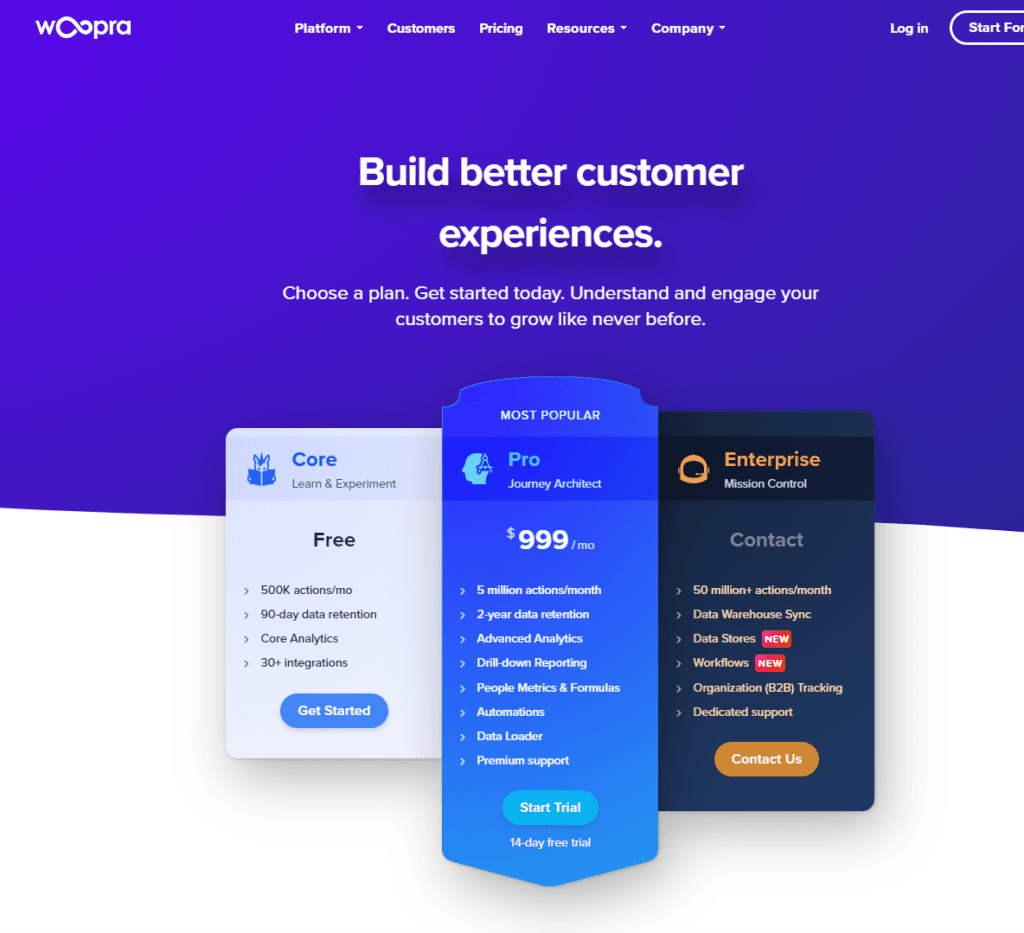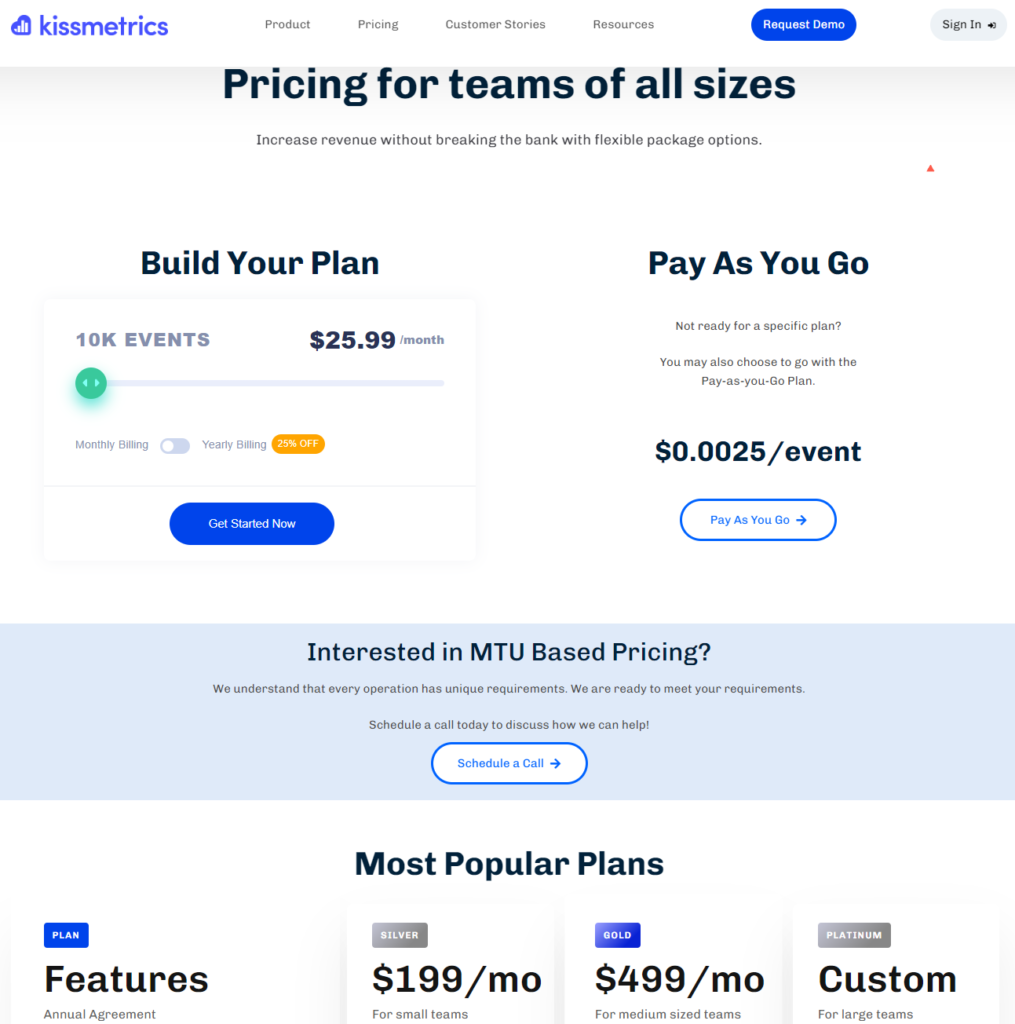Choosing between analytics tools can feel like being a kid in a candy store overwhelming because everything looks good. But when it’s about understanding your audience, not all sweets or in our case, tools are created equal. Today, we’re slicing through the noise to compare two giants in the analytics world: Woopra and Kissmetrics. Both promise to unlock the secrets of your data, but which one truly holds the key to your business’s heart? Let’s find out, starting with a look at user-friendliness and ease of use.
Woopra | Kissmetrics |
|---|---|
| G2 Score – 4.4 out of 5 stars | G2 Score – 4.1 out of 5 stars |
| TrustRadius Score – 5.8/10 | TrustRadius Score – 9.6/10 |
User-Friendliness: Your First Date with Analytics
Remember your first day at a new job? Exciting but kind of nerve-wracking, right? That’s how meeting a new analytics tool can feel. You want something that welcomes you with open arms, not something that requires a PhD to understand. Let’s see how Woopra and Kissmetrics stack up in the “ease of use” department.
Woopra: Like Your Friendly Neighborhood Barista
Woopra aims to be the friendly neighborhood barista of the analytics world. It welcomes you, knows your name (or at least your business’s needs), and doesn’t overwhelm you with options. Setting up Woopra is straightforward. You insert a bit of code into your website, and voila, you’re ready to start tracking. The dashboard is clean, with intuitive navigation that guides you through your data without making you feel lost.
Woopra’s real magic, though, is in how it simplifies complex data. It breaks down user actions into easy-to-understand insights, making it easier for you to make informed decisions without digging through piles of raw data. Plus, its customer journey tracking feature visually represents how users interact with your site, turning what could be a complicated analysis into a simple, clear path.
Kissmetrics: The Professor Who Loves Charts
Kissmetrics, on the other hand, is like that professor who loves to dig deep into subjects. It offers robust features that cater to those who love to get into the nitty-gritty of data. Setting up Kissmetrics involves a bit more than just copying and pasting code—you’ll need to define specific events and properties to track. This setup process gives you control but requires a steeper learning curve.
Once you’re in, Kissmetrics rewards you with detailed, actionable insights. Its dashboard and reporting tools are powerful, offering a range of visualizations that help you understand your data at a granular level. For businesses that thrive on deep data analysis, Kissmetrics is like a goldmine, offering the tools needed to uncover hidden insights.
Integration Capabilities: The Make-or-Break Factor
In the world of digital tools, being a lone wolf doesn’t cut it. Integration is the name of the game. How well an analytics tool plays with others be it your CRM, email marketing software, or customer support platform can make a world of difference. So, let’s dive into how Woopra and Kissmetrics fare when it comes to playing nice with the rest of your tech stack.
Woopra: The Social Butterfly
Woopra is what you’d call the social butterfly of analytics tools. It boasts a wide range of integrations with popular platforms, making it a breeze to connect with your existing tech stack. From email services like Mailchimp to CRMs like Salesforce, Woopra doesn’t just connect; it integrates deeply, allowing for a seamless flow of data across platforms.
The beauty of Woopra’s approach is in how these integrations enhance its core functionalities. For instance, by linking Woopra with your email platform, you can track how email campaigns influence user behavior on your website or app. This isn’t just about seeing data side by side; it’s about merging streams of data to get a holistic view of your customer’s journey. Woopra’s integrations are designed to be straightforward, minimizing the technical heavy-lifting and making it accessible even if you’re not a tech wizard.
Kissmetrics: The Selective Networker
Kissmetrics, on the other hand, takes a more selective approach to integration. It focuses on quality over quantity, offering integrations with key platforms that are crucial for deep data analysis. While it might not have the extensive list that Woopra boasts, Kissmetrics ensures that its integrations add significant value, enhancing its core offering of detailed user analytics.
Kissmetrics shines when it comes to integrating with e-commerce platforms like Shopify and payment processors like Stripe. These integrations are not superficial; they allow businesses to drill down into customer purchase behavior, calculate lifetime value, and perform cohort analysis with precision. Setting up these integrations requires a bit more effort compared to Woopra, but the payoff is in the depth of insights you can derive.

Related: Check out our free SEO suite

Customer Support and Community: Navigating the Analytics Journey Together
Venturing into the analytics landscape can feel like embarking on an epic journey. You’ll encounter challenges, face questions, and sometimes, you might even get lost. This is where customer support and community play a crucial role. They’re your guides, your map, and sometimes, your lifeline. Let’s see how Woopra and Kissmetrics stand by their users through thick and thin.
Woopra: Your Friendly Guide
Woopra approaches customer support with the same user-friendly ethos that defines its product. It offers a variety of support channels, including email support, a comprehensive knowledge base, and live chat for immediate assistance. What stands out about Woopra is the accessibility of its support. Whether you’re a small startup or a large enterprise, Woopra treats your queries with urgency and care.
Beyond the traditional support channels, Woopra also boasts a community of users. This community serves as a forum for sharing best practices, troubleshooting, and providing feedback directly to the Woopra team. It’s like having a network of fellow travelers who’ve been through the same paths and can offer their wisdom and insights. This community aspect adds a layer of support that goes beyond the official channels, fostering a sense of camaraderie among Woopra users.
Kissmetrics: The Knowledgeable Expert
Kissmetrics, true to its data-driven nature, takes a more analytical approach to customer support. It provides detailed documentation and a robust knowledge base that allows users to deep-dive into the platform’s capabilities. For more personalized support, Kissmetrics offers email and chat support, with a focus on providing detailed, technical answers to your queries.
Kissmetrics doesn’t have as pronounced a community aspect as Woopra, but it compensates with the depth of its knowledge base. The resources available are geared towards helping users understand not just the how but also the why behind analytics practices. This makes Kissmetrics’ support invaluable for users who seek to not only solve immediate issues but also to gain deeper insights into analytics as a discipline.
Pricing: The Investment in Insights
Finally, let’s talk about the elephant in the room: pricing. In the world of business tools, cost is a critical factor. It’s not just about the sticker price; it’s about the return on investment. An analytics tool can be pricey, but if it unlocks new opportunities, optimizes your marketing spend, or enhances customer retention, it’s worth its weight in gold. How do Woopra and Kissmetrics stack up in this crucial area? Let’s dive in.
Woopra: Flexible Pricing for Growing Businesses
Woopra offers a tiered pricing structure designed to accommodate businesses of all sizes, from startups to large enterprises. It starts with a free plan, which provides a solid foundation for basic analytics needs, including real-time data, basic segmentation, and funnel analysis. This is a great option for small businesses or startups just beginning their analytics journey.
As your needs grow, so does Woopra’s pricing flexibility. Its paid plans increase in features, data retention, and support, scaled to match the size and complexity of your business operations. The pricing is transparent, with each tier offering a clear breakdown of features and limits, helping businesses forecast their investment and avoid surprises.
One of the highlights of Woopra’s pricing model is its commitment to scalability. As your business grows, you can move up tiers to access more advanced features, like detailed segmentation, behavioral analytics, and custom reporting, ensuring that your analytics capabilities grow with your business.
Kissmetrics: In-Depth Insights for Serious Marketers
Kissmetrics positions itself as a premium option in the analytics space, with pricing that reflects its focus on providing deep, actionable insights. There’s no free plan, which means businesses looking to use Kissmetrics need to be ready to invest from the get-go. However, for that investment, they gain access to a suite of powerful analytics tools designed for serious marketers and product managers.
The pricing structure of Kissmetrics is built around the depth of analytics and the volume of data processed. This makes it more suitable for medium to large businesses or those with significant online transactions where the value of deep customer insights can quickly offset the cost of the tool.
Kissmetrics emphasizes the value of understanding your customer’s journey at a granular level, enabling businesses to make informed decisions that can significantly impact conversion rates and customer retention. The investment in Kissmetrics is justified for businesses that can leverage its advanced features to drive substantial improvements in their marketing and product strategies.
Innovation and Future-Proofing: Staying Ahead in the Analytics Game
In the fast-paced world of digital marketing and product management, the ability of a tool to adapt and evolve is not just a nice-to-have; it’s essential. Analytics tools that continually innovate and anticipate future trends not only provide a competitive edge today but also ensure they remain relevant and valuable to your business in the long run. How do Woopra and Kissmetrics stack up in terms of innovation and preparing users for future challenges?
Woopra: Embracing the Evolution of Customer Analytics
Woopra has consistently demonstrated a commitment to innovation, focusing on providing a holistic view of the customer journey. Its development roadmap includes enhancements in artificial intelligence (AI) and machine learning (ML) capabilities, aiming to offer more predictive insights about customer behavior. This forward-thinking approach ensures that businesses using Woopra can stay ahead of the curve, not just in understanding past and present customer actions but in anticipating future trends and behaviors.
Furthermore, Woopra’s flexibility and adaptability in integration play a significant role in its future-proofing strategy. By continuously expanding its ecosystem of integrations, Woopra ensures that it can work seamlessly within the rapidly evolving digital tool landscape, thus protecting your investment in the platform over time.
Kissmetrics: Deepening Insights with Advanced Analytics
Kissmetrics has built its reputation on providing deep, actionable insights, and it continues to push the boundaries in this area. The platform is investing in advanced segmentation and cohort analysis features, making it an even more powerful tool for understanding nuanced customer behaviors and trends. This focus on deep analytics ensures that businesses relying on Kissmetrics can extract maximum value from their data, uncovering opportunities for optimization and growth that would otherwise remain hidden.
Moreover, Kissmetrics’ emphasis on e-commerce and transaction-based businesses means it is continually refining its tools to better serve these sectors. As online shopping and digital transactions evolve, Kissmetrics evolves alongside, ensuring that its users have access to the most relevant and powerful analytics tools for their specific needs.
Pricing
Woopra:

Kissmetrics:

Conclusion
In wrapping up our deep dive into the analytics powerhouses of Woopra and Kissmetrics, it’s evident that both platforms offer robust tools designed to unlock valuable insights into customer behavior and business performance. The choice between them hinges on your specific business needs, analytical capabilities, and future goals.
Woopra stands out for its user-friendliness, broad integration capabilities, and a strong emphasis on real-time, holistic customer journey analytics. Its commitment to innovation, particularly in predictive analytics, ensures it remains a forward-thinking choice for businesses focused on comprehensive customer insights. With a flexible pricing model and a supportive community, Woopra is well-suited for businesses seeking an accessible, scalable analytics solution.
Kissmetrics, on the other hand, excels in delivering deep, actionable insights with a focus on e-commerce and transaction-based analytics. Its strengths lie in advanced segmentation, cohort analysis, and a deep dive into the nuances of customer behavior. While it comes at a premium, the investment is justified for businesses that require detailed analytics to drive strategic decisions. Its ongoing innovation ensures it remains relevant, particularly for businesses that depend on sophisticated, data-driven strategies for growth.
Read Next:
- GetResponse vs Zoho Campaigns: The Best Email Marketing Tool for 2024
- AWeber vs ActiveCampaign: The Best Email Marketing Tool
- Constant Contact vs Campaigner: Best Email Marketing Tool
- GetResponse vs Omnisend: The Best Email Marketing Tool for 2024
- AWeber vs Benchmark Email: The Best Email Marketing Tool






















Comments are closed.